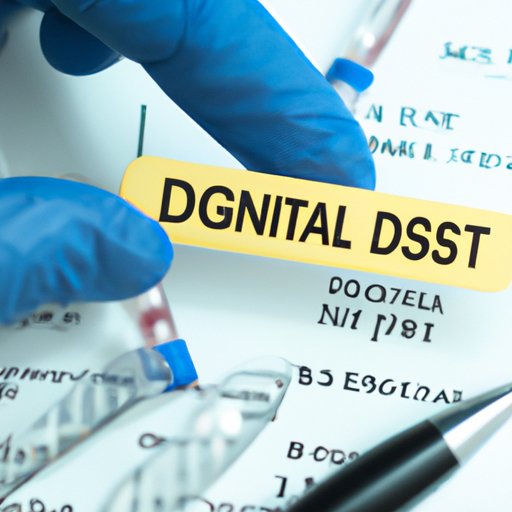Introduction
DNA profiling is a technique used to identify an individual through their unique genetic code. It has revolutionized the fields of criminal investigation and forensic science by providing a more accurate and reliable way to identify individuals and solve cases. Through the use of DNA profiling, law enforcement is now able to investigate cases that were previously thought to be unsolvable and bring perpetrators to justice.
How has DNA Profiling Helped to Solve Cold Cases?
The ability to identify an individual through DNA profiling has allowed law enforcement to solve cases that have gone unsolved for years, often referred to as “cold cases”. In many cases, investigators are able to collect DNA from items such as clothing or weapons that were found at the crime scene. This DNA can then be compared to other samples in databases to identify suspects or link them to other cases. According to Dr. Mark Perlin of Cybergenetics, “DNA evidence can link a suspect to a crime in ways that no other evidence can.”
One example of a cold case solved with the help of DNA profiling is the “Golden State Killer” case in California. After decades of investigation, authorities were able to match DNA collected from the crime scenes with a DNA sample from a relative of the suspect, Joseph DeAngelo. This breakthrough allowed them to finally identify and apprehend DeAngelo, who was later convicted of 13 counts of murder and 13 counts of kidnapping.
Identification of Victims of Violent Crimes
DNA profiling has also been instrumental in identifying victims of violent crimes who may have otherwise remained unknown. In cases where a body cannot be identified by traditional methods, such as fingerprinting or dental records, DNA profiling can provide a valuable tool for identification. DNA can be collected from remains or items associated with the victim and compared to DNA samples from family members.
One example of this is the case of a woman known as “Buckskin Girl”, who was found murdered in Ohio in 1981. After nearly 40 years of investigation, her identity was finally revealed in 2020 when her DNA was matched to that of her family members. Through DNA profiling, investigators were able to find the identity of the victim and bring closure to her family.

Exoneration of Wrongly Convicted Individuals
DNA profiling has also been instrumental in exonerating individuals who have been wrongfully convicted. In some cases, DNA evidence from the crime scene has been used to prove that the individual convicted of the crime was not the perpetrator. This has resulted in numerous individuals being released from prison after being wrongfully convicted.
One example of this is the case of Timothy Cole, who was wrongfully convicted of rape in Texas in 1986. After his death in 1999, DNA evidence from the crime scene was tested and it was determined that he was not the perpetrator. Cole was posthumously exonerated in 2009 and his family received a state apology for his wrongful conviction.
Use of DNA Profiling in Convicting the Guilty
In addition to exonerating wrongfully convicted individuals, DNA profiling has also been used to successfully convict those responsible for committing crimes. By matching a sample of DNA from the crime scene to a sample taken from a suspect, prosecutors are able to build a strong case against them. This has led to many successful convictions and has provided justice to victims of crime.
One example of this is the case of John Harrison, who was convicted in 2008 of murdering his wife in Florida. His conviction was based largely on the fact that his DNA was found at the crime scene. This evidence was enough to convince the jury of his guilt and he was sentenced to life in prison.

Comparison of Accuracy of DNA Profiling to Other Forensic Techniques
DNA profiling has proven to be far more accurate than other forensic techniques, such as fingerprint analysis or ballistics. According to a study conducted by the National Institute of Justice, DNA testing is 99.9% accurate in correctly identifying individuals. This level of accuracy makes it one of the most reliable tools for criminal investigation.
One example of the superiority of DNA profiling is the case of Michael Morton, who was wrongfully convicted of murder in Texas in 1987. His conviction was based largely on circumstantial evidence and faulty testimony. After DNA evidence from the crime scene was tested, it was determined that Morton was not the perpetrator and he was eventually exonerated in 2011.

Importance of DNA Profiling in Solving Complex Criminal Investigations
DNA profiling has become increasingly important in solving complex criminal investigations. In many cases, DNA evidence can provide crucial clues that can lead investigators to the perpetrator of a crime. It can also be used to link multiple suspects to a single crime or to link multiple crimes committed by the same individual.
One example of this is the case of the “Grim Sleeper” serial killer in Los Angeles. Over the course of two decades, DNA evidence was used to link numerous murders to one suspect, Lonnie Franklin Jr. He was eventually convicted of 10 counts of murder and sentenced to life in prison in 2016.
Conclusion
DNA profiling has revolutionized the field of forensic science and has had a profound impact on criminal investigations. Through DNA profiling, law enforcement is now able to solve cases that were previously thought to be unsolvable, identify victims of violent crimes, exonerate wrongfully convicted individuals, and convict the guilty. DNA profiling has also proven to be far more accurate than other forensic techniques, making it an invaluable tool for justice.
(Note: Is this article not meeting your expectations? Do you have knowledge or insights to share? Unlock new opportunities and expand your reach by joining our authors team. Click Registration to join us and share your expertise with our readers.)
